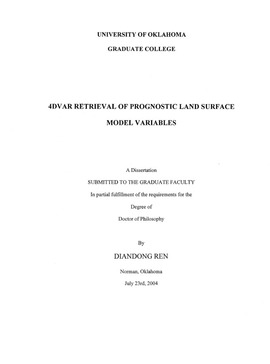| dc.contributor.advisor | Xue, Ming, | en_US |
| dc.contributor.author | Ren, Diandong. | en_US |
| dc.date.accessioned | 2013-08-16T12:20:51Z | |
| dc.date.available | 2013-08-16T12:20:51Z | |
| dc.date.issued | 2004 | en_US |
| dc.identifier.uri | https://hdl.handle.net/11244/1232 | |
| dc.description.abstract | The major findings of the first type of retrieval are: Initial soil moisture contents as well as deep soil temperature can all be successfully retrieved, for realistic initial guess errors; the relative difficulty in retrieving superficial and deep soil moisture contents depends on the vegetation coverage and growth conditions; the revision to the soil temperature equations as documented in a separate paper is found critical in retrieval with real OASIS data; daytime observations are found much more effective because of their higher signal to noise ratio; assimilation window length up to ten days is found to produce the better retrievals. This signifies the value of information contents. | en_US |
| dc.description.abstract | For numerical weather prediction models, it is critically important to properly initialize its land surface model component. This study demonstrates successful variational retrievals of land surface states by assimilating either skin temperature or screen-level atmospheric measurements. For this purpose, the land surface model is first validated against the Oklahoma Atmospheric Surface Layer Instrumentation System (OASIS) measurements. Refinements to the model were found necessary. | en_US |
| dc.description.abstract | Two distinct retrieval problems are tackled in this study. One uses skin temperature as the observation and one uses observations of near surface atmospheric variables. The former is done using a land surface model and its adjoint in a stand-alone mode, forced by observed meteorological parameters. A 4D variational (4DVAR) retrieval system is developed in which the cost-function is defined as a quadratic measurement of the model forecasting error in ground surface or skin temperature. The latter involves a 1D land surface-atmosphere model, the corresponding adjoint codes, and a definition of cost function that measures misfit between observed and modeled screen-level atmospheric temperature and specific humidity. | en_US |
| dc.description.abstract | For the second retrieval problem, the Medium Range Forecast (MRF) PBL model is implemented within the Advanced Regional Prediction System (ARPS), forming a coupled LSM-PBL model. We show that under ideal synoptic conditions, land surface prognostic variables can also be successfully retrieved from the screen-level atmospheric observations. The retrieval scheme is robust when subject to observational errors with magnitudes comparable to instrument accuracy, and for initial guess errors larger than typical model forecast errors. Compared to the early case, the validity period for tangent linearization is shorter due to feedbacks from atmospheric components. There exists an optimal assimilation window length resulting from the contest between degrading forecast accuracy and increasing necessary information content. For a moist period tested, taking the scheme efficiency into consideration, a length of about six hours seems to be a suitable assimilation window length. | en_US |
| dc.format.extent | x, 228 leaves : | en_US |
| dc.subject | Environmental Sciences. | en_US |
| dc.subject | Numerical weather forecasting. | en_US |
| dc.subject | Hydrology. | en_US |
| dc.subject | Soil moisture Measurement. | en_US |
| dc.subject | Atmosphere Mathematical models. | en_US |
| dc.title | 4DVAR retrieval of prognostic land surface model variables. | en_US |
| dc.type | Thesis | en_US |
| dc.thesis.degree | Ph.D. | en_US |
| dc.thesis.degreeDiscipline | School of Meteorology | en_US |
| dc.note | Adviser: Ming Xue. | en_US |
| dc.note | Source: Dissertation Abstracts International, Volume: 68-06, Section: B, page: 3648. | en_US |
| ou.identifier | (UMI)AAI3270680 | en_US |
| ou.group | College of Atmospheric & Geographic Sciences::School of Meteorology | |
